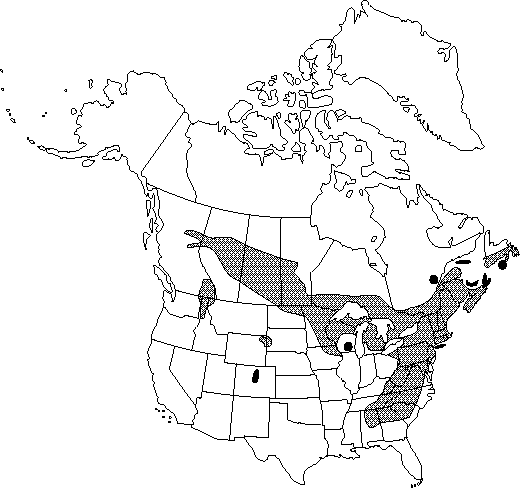Difference between revisions of "Corylus cornuta subsp. cornuta"
FNA>Volume Importer |
FNA>Volume Importer |
||
| Line 26: | Line 26: | ||
}}<!-- | }}<!-- | ||
| − | --><span class="statement" id="st- | + | --><span class="statement" id="st-undefined" data-properties=""><b>Shrubs,</b> open spreading, to (4–)6 m. <b>Bark</b> light brown, smooth. <b>Branches</b> ascending; twigs glabrous to sparsely pubescent, without glandular hairs. <b>Winter</b> buds containing inflorescences ovoid, 3–5 × 3–4 mm, apex acute. <b>Leaves</b>: petiole glabrous to moderately pubescent, without glandular hairs. <b>Leaf</b> blade ovate to obovate or narrowly elliptic, often nearly angular and lobulate near apex, 5–12 × 3.5–9 cm, base narrowly cordate to narrowly rounded, margins coarsely and often irregularly doubly serrate, apex usually distinctly acuminate; surfaces abaxially glabrous to moderately pubescent, usually pubescent on major veins and in vein axils. <b>Inflorescences</b>: staminate catkins usually in clusters of 2–3, 4.5–6 × 0.5–0.8 cm; peduncles mostly 0.5–2 mm. <b>Nuts</b> in clusters of 2–6; involucral tubular beak long, narrow, 2–3(–4) times length of nuts, densely bristly. <b>2n</b> = 22, 28.</span><!-- |
-->{{Treatment/Body | -->{{Treatment/Body | ||
| Line 57: | Line 57: | ||
|publication year= | |publication year= | ||
|special status=Endemic;Selected by author to be illustrated | |special status=Endemic;Selected by author to be illustrated | ||
| − | |source xml=https://jpend@bitbucket.org/aafc-mbb/fna- | + | |source xml=https://jpend@bitbucket.org/aafc-mbb/fna-data-curation.git/src/9216fc802291cd3df363fd52122300479582ede7/coarse_grained_fna_xml/V3/V3_599.xml |
|subfamily=Betulaceae subfam. Coryloideae | |subfamily=Betulaceae subfam. Coryloideae | ||
|genus=Corylus | |genus=Corylus | ||
|species=Corylus cornuta | |species=Corylus cornuta | ||
|subspecies=Corylus cornuta subsp. cornuta | |subspecies=Corylus cornuta subsp. cornuta | ||
| − | |||
| − | |||
| − | |||
| − | |||
| − | |||
| − | |||
| − | |||
| − | |||
| − | |||
| − | |||
| − | |||
| − | |||
| − | |||
| − | |||
| − | |||
| − | |||
| − | |||
| − | |||
| − | |||
| − | |||
| − | |||
| − | |||
| − | |||
| − | |||
| − | |||
| − | |||
| − | |||
| − | |||
| − | |||
| − | |||
}}<!-- | }}<!-- | ||
-->[[Category:Treatment]][[Category:Corylus cornuta]] | -->[[Category:Treatment]][[Category:Corylus cornuta]] | ||
Revision as of 13:44, 27 July 2019
Shrubs, open spreading, to (4–)6 m. Bark light brown, smooth. Branches ascending; twigs glabrous to sparsely pubescent, without glandular hairs. Winter buds containing inflorescences ovoid, 3–5 × 3–4 mm, apex acute. Leaves: petiole glabrous to moderately pubescent, without glandular hairs. Leaf blade ovate to obovate or narrowly elliptic, often nearly angular and lobulate near apex, 5–12 × 3.5–9 cm, base narrowly cordate to narrowly rounded, margins coarsely and often irregularly doubly serrate, apex usually distinctly acuminate; surfaces abaxially glabrous to moderately pubescent, usually pubescent on major veins and in vein axils. Inflorescences: staminate catkins usually in clusters of 2–3, 4.5–6 × 0.5–0.8 cm; peduncles mostly 0.5–2 mm. Nuts in clusters of 2–6; involucral tubular beak long, narrow, 2–3(–4) times length of nuts, densely bristly. 2n = 22, 28.
Phenology: Flowering very early spring.
Habitat: Moist to dry roadsides, edges of woods, fencerows, waste places, and thickets, or as understory in open woodlands
Elevation: 100–500 m
Distribution

St. Pierre and Miquelon, Alta., B.C., Man., N.B., Nfld., N.S., Ont., P.E.I., Que., Sask., Ala., Colo., Conn., Ga., Idaho, Iowa, Ky., Maine, Md., Mass., Mich., Minn., Mont., N.H., N.J., N.Y., N.C., N.Dak., Ohio, Pa., R.I., S.C., S.Dak., Tenn., Vt., Va., Wash., W.Va., Wis., Wyo.
Discussion
Like Corylus americana Walter, the beaked hazel (C. cornuta subsp. cornuta) is a weedy shrub and is sometimes considered a pest in carefully managed northern forests. The fruits are similar to those of C. americana, except that the surrounding bracts are connate into a long, narrow, tubular beak. Vegetative individuals of C. cornuta subsp. cornuta can be distinguished from C. americana by the absence of glandular hairs on the petioles and young twigs.
Selected References
None.
